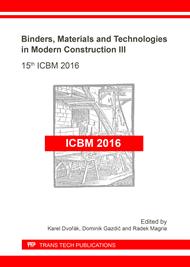p.3
p.10
p.15
p.21
p.29
p.35
p.40
p.45
p.51
The Effect of Particle Size Distribution of Lime on Properties of the Autoclaved Calcium Hydrosilicate Materials
Abstract:
This investigation was made to examine how the particle size of lime influence the properties of calcium hydrosilicate materials. Quicklime was sorted in three fractions: 0-1 mm, 1-11.2 mm and 11.2.-22.4 mm. Slaked lime putties were prepared in the laboratory by mixing lime fractions and deionized water under vigorous stirring. The C/H ratio was 1:8. The lime putties were mixed with finely ground sand with the C/S ratio equal to 0.85. The hydrosilicate materials were prepared under hydrothermal conditions: temperature 205 °C, pressure 16 bar. This work focuses on lime putty rheological behaviour and on composition and properties of lime hydrosilicates. It was found that hydrated particles of fractionated lime form smaller aggregates than standard lime. Plasticity increases with the increasing size of fraction. When separate fractions are used, 11.3 Å tobermorite crystallization is slower.
Info:
Periodical:
Pages:
29-34
Citation:
Online since:
October 2017
Authors:
Price:
Сopyright:
© 2017 Trans Tech Publications Ltd. All Rights Reserved
Share:
Citation:


